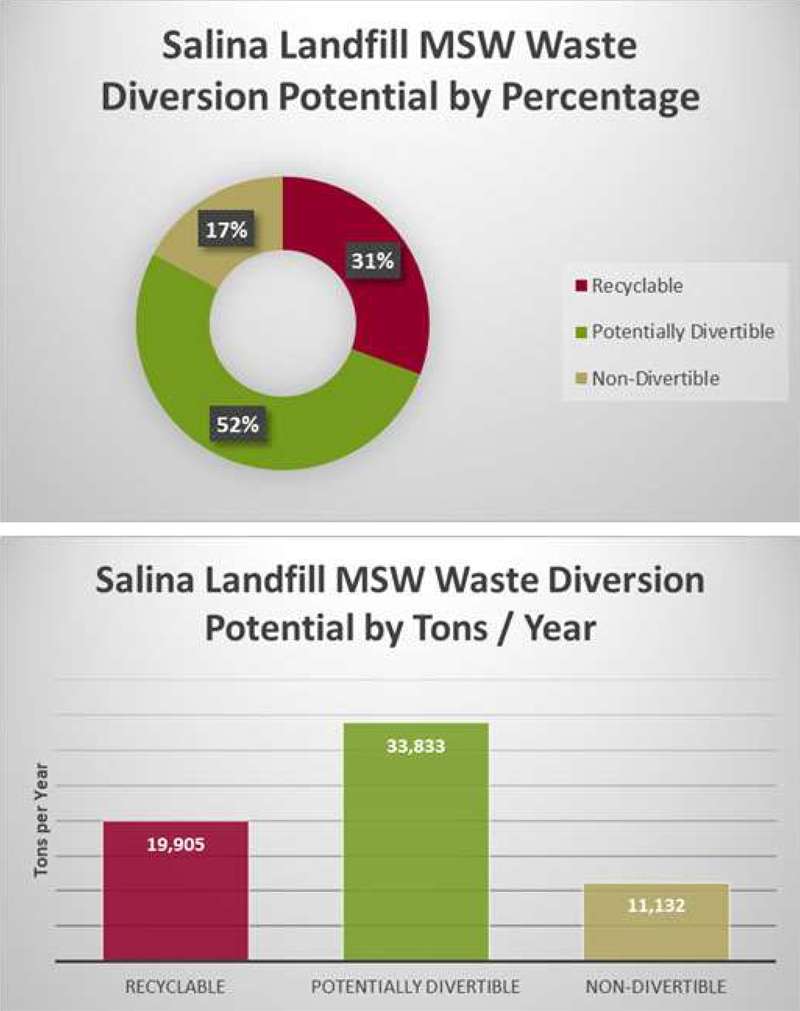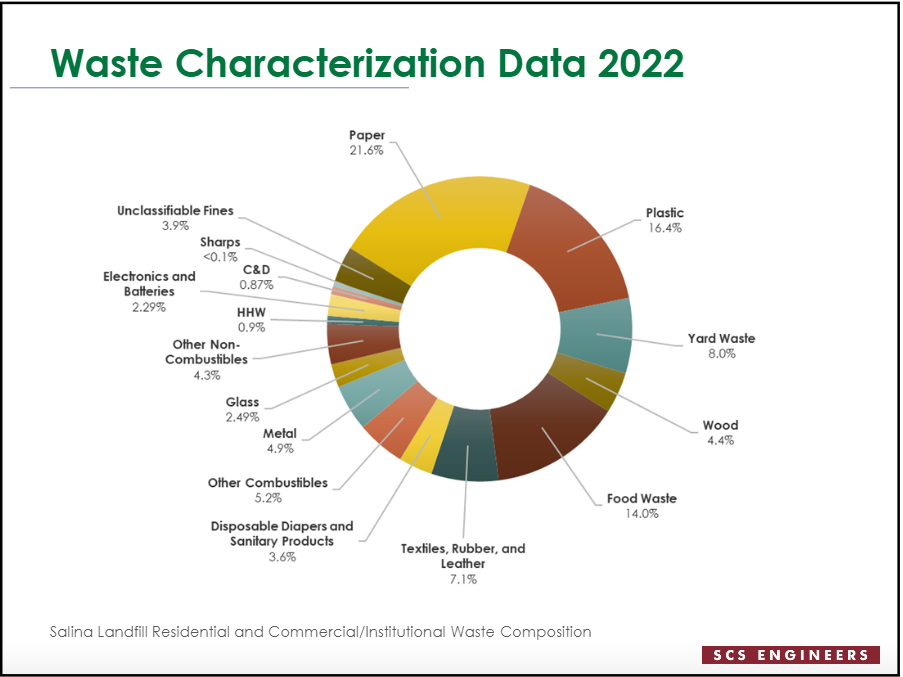By NATE KING
Salina Post
The City of Salina's sanitation department collects approximately 95,000 tons of waste annually. Where does all that garbage go? The Salina Municipal Landfill. James Teutsch, public works director for the City of Salina, said at the city commission study session this week that The City of Salina is working to be at "Zero Waste" by 2050.
What does "Zero Waste 2050" mean?
Getting to actual zero waste is impossible. Humans will always have waste. Mayor Mike Hoppock put into context what the working definition of Zero Waste means for Salina.
"'Zero Waste' is defined as a philosophy that promotes reuse, recycling, and conservation programs. And also emphasizes sustainability for the entire lifecycle of products. Also, we do a lot of stuff with the landfill. The city has a landfill, how can we conserve that landfill to last as long as possible? By reducing trash, you also extend the life of that landfill for however long it's useful for your community," Hoppock said.
2022 Waste Characterization Study
Last year consultants with SCS Engineering in Wichita and City of Salina Sanitation employees, conducted a waste characterization study where they took samples from the landfill and analyzed each piece of waste and categorized it based on what type of waste it was. At the work session, Renee Crenshaw, an SCS engineer, presented the studies findings to commissioners.

"Different types of plastic, paper, food waste, textiles we looked at this wide range of items, categorized them into bins and weighed them and came up with percentages for what we thought based on this little snapshot in time, what kind of trash the Salina landfill was was receiving from a residential standpoint, and from a municipal solid waste standpoint. I think we have 20 different categories," Crenshaw said.
The goal of the 2022 study was to provide the city with a deeper understanding of its waste streams, enabling data-driven and evidence-based decisions that result in efficient use of resources and progress toward increased waste reduction, and allow for a comparison to historical studies.

In order to get a better grasp on commercial waste, The team of engineers with SCS, took a look at how two area businesses, Martinelli's, 158 S. Santa Fe Avenue, and Dillon's, 1201 W. Crawford Street, currently manage their organic waste and what sustainable strategies have been implemented to reduce waste and encourage recycling.
According to the study, a robust compost program was established at Dillon’s a year and a half ago, beginning in a pilot program in the store off of S. Ohio Street in Salina. Greg Moore worked at that store at the time and assisted with the pilot program. The pilot program resulted in decreased trash generation and it reduced the frequency of dumpster emptying from once every eight or nine days to once every 20 days or so.
A reduction in landfill disposal costs were observed, although the study indicated these costs may be offset by the costs to transport composted materials to a third party in Hutchinson. The study found that the Dillon's on W. Crawford Street composts a total of 1,350 gallons per week, which equates to approximately 70,200 gallons per year.
Almost all Dillon’s stores have begun to roll-out the program, except for some of the smaller stores in more rural areas. At the time of the study, the W. Crawford Street store was still in the process of rolling out its organics program. The store has already seen benefits from the program, such as the required frequency of emptying the trash dumpster being reduced from once every seven to eight days to once every 14 to 15 days.
For 20 years, Martinelli’s has recycled its used oil via a third-party company, Darling Ingredients, who uses it to make biofuel. Used cooking oil is collected from the kitchen and transferred to a used oil container located behind the restaurant. Once a month, this container is emptied.
The employees at Martinelli’s also work hard to utilize all parts of the foods in their recipes, including “ugly” produce. For example, a lot of their vegetable scraps are used in their steak soups. They also pay close attention to expiration dates, and work hard to use food before it expires. When carry out orders are not picked up, Martinelli’s donates them to the Rescue Mission or similar organizations. This helps avoid cooked, edible food from being thrown away.
During the discussion on Monday, Vice Mayor Bill Longbine, asked how many years the Salina Landfill has left before it is at capacity.
"The landfill has about 180 years of life," Teutsch said. "We had talked about compacting and the efficiencies of needing to combat that waste as well as possible, and I think it's just important to mention that the landfill is a revenue-generating part of the City of Salina. So when we look at this, it is in our best interest to try to develop the most thoughtful, the most detailed, the most comprehensive, the most efficient way of going about building this zero waste initiative across a 30-year time span."
Teutsch said that The City of Salina builds nine-acre landfill cells on a five-year cycle.
"Because we bond each of those cells, and then the landfill revenue pays for those cells," Teutsch said. "So generally speaking, we're thinking with just a typical landfill cell of the size that we build around nine acres, in a five year period, it's around two and a half million dollars."
According to the study, the City of Salina has a history of tracking the amount and types of materials of municipal solid waste disposed at the Salina Landfill. These efforts have helped the city better understand its waste stream, develop policies and programs that reduce waste, encourage recycling, and facilitate sustainable materials management (SMM). The city recognizes there are additional opportunities for continued waste reduction and recycling in addition to its current programs.
Over the last two decades, the city has commissioned three waste characterization studies to quantitatively and qualitatively measure waste disposal. The historical studies were conducted in 1996-1997 and 2004.
During their presentation, SCS engineers thanked the Salina Drive-thru Recycling Center for allowing access to their site, waste receipts, and for allowing the SCS team to use available equipment and staff resources to aid in obtaining and sorting samples.
2023 Community Survey
Since the completion of the Waste Characterization study in 2o22, SCS engineers have went to work studying the data and identifying areas of waste that can be reduced, or better yet, recycled.
"We met with the Zero Waste initiative group in September and we have the public opinion survey, which is going to focus on seeking information about what the community thinks about recycling, composting, other types of material diversion, how important it is to them. It's intended to go live on Monday," Crenshaw said.
The 18-question survey, which will be distributed starting Monday, will ask citizens of Salina questions about their opinions and feelings relating to recycling, composting, reusing, and reducing. The survey will have behavioral questions like, "How often do you use the Salina Drive-thru Recycle Center?" and "How much would you be open to paying for curbside recycling?"
"The public online survey is going to be on a Survey Monkey web link, I believe that there's some advertisement that's going to go out with a water bill, like a couple of lines at the bottom of everyone's water bill for a month, it'll be open from Jan. 30 to March 3. And then, there'll also be some information on the City of Salina website and media with the other Facebook as well, to kind of advertise and seek public engagement for that," Crenshaw said.
To view the entire 2022 Waste Characterization Study and more information regarding the Salina Landfill, click here.





